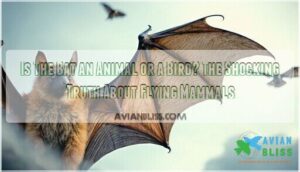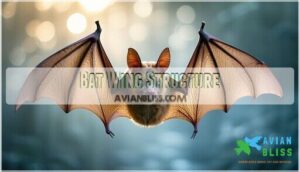This site is supported by our readers. We may earn a commission, at no cost to you, if you purchase through links.

All birds are animals, but bats belong to a specific group called mammals. Think of it this way: bats give birth to live babies and nurse them with milk, just like cats or dogs do.
Birds lay eggs and have feathers, while bats have fur and leathery wings made of stretched skin between their finger bones. It’s like comparing apples to oranges – both are fruit, but they’re completely different types.
Bats evolved flight separately from birds millions of years ago, creating one of nature’s most fascinating examples of convergent evolution.
Table Of Contents
Key Takeaways
- You’re looking at a mammal, not a bird – Bats are warm-blooded mammals that give birth to live young, produce milk, and have fur rather than feathers
- You can distinguish them by their wing structure – Bat wings are stretched skin membranes between elongated finger bones, completely different from birds’ feathered wings
- You’ll find they evolved flight independently – Bats developed their flying abilities separately from birds around 50 million years ago through convergent evolution
- You benefit from their essential ecological roles – These flying mammals serve as vital pollinators, pest controllers, and seed dispersers that maintain healthy ecosystems worldwide
Bats Biological Classification
You’ve likely wondered whether bats belong with mammals or birds when you see them flying through the night sky.
Despite their impressive flight abilities, bats are actually mammals that share more biological traits with dogs and cats than with eagles or sparrows.
Bats may look like flying mice, but they’re mammals through and through—closer kin to your pet dog than any bird.
Mammal Characteristics
You’ll discover that bats share essential mammal traits with other warm-blooded creatures.
These flying mammals possess distinct mammal features that clearly separate them from birds in animal classification systems.
Key mammal vs bird distinctions include:
- Fur presence – Bats have hair-covered bodies for insulation, unlike feathered birds
- Milk production – Female bats nurse young through mammary glands
- Body structure – Dense bones and lungs match other bat species, not hollow bird bones
Bird Characteristics
Birds typically possess distinct characteristics that clearly differentiate them from mammals like bats.
You’ll notice birds have feathers for insulation and flight, while their beaks serve specialized feeding functions.
Bird species demonstrate remarkable wing movement patterns during flight and seasonal bird migration behaviors.
| Bird Characteristic | Function/Purpose |
|---|---|
| Feather Structure | Temperature regulation and flight |
| Beak Functions | Feeding and tool manipulation |
| Wing Movement | Powered flight mechanics |
| Nesting Habits | Reproduction and offspring care |
Understanding these bird characteristics helps clarify animal classification differences.
Unlike flying mammals, birds lay eggs and lack mammary glands for feeding young.
Key Differences Between Mammals and Birds
You’ll notice stark contrasts between these animal groups.
Mammal traits include hair or fur, live birth, and milk production for offspring.
Bird features center on feathers, egg-laying, and hollow bones.
Both are warm blooded, but feathered friends possess beaks while mammal species have teeth.
These species classification differences help distinguish bat wings from true bird characteristics in the animal kingdom, which are key to understanding the animal kingdom.
Is Bat an Animal
When you’re trying to figure out what category bats belong to, the answer might surprise you.
Yes, bats are definitely animals – specifically, they’re mammals in the animal kingdom.
This Animal Classification places them alongside dogs, cats, and humans rather than with birds.
Despite their ability to fly, bats share essential Mammal Traits that set them apart from our feathered friends.
Here’s what makes bats true mammals:
- They’re warm-blooded and regulate their own body temperature
- Female bats produce milk to nurse their young, just like other mammal species
- They have hair or fur covering their bodies, not feathers
Wildlife biology confirms that bat wings are actually modified hands with stretched skin membranes, completely different from bird wings.
Bat Behavior includes roosting in caves and trees, while their bat habitat spans worldwide ecosystems.
Understanding proper Species Identification helps Wildlife Conservation efforts protect these essential mammals that play important ecological roles in our environment.
Bats have unique ground takeoff limitations that distinguish them from other flying creatures.
Bats Evolutionary History
You’re about to discover how bats evolved from ancient mammals around 50 million years ago, developing their unique flying abilities through millions of years of adaptation.
This evolutionary journey explains why bats are mammals with wings rather than birds, despite their ability to fly.
Origins of Bats
You’ll find that bat ancestors emerged around 50 million years ago during the Eocene epoch.
Fossil records show primitive bats like Icaronycteris already possessed flight capabilities. These mammal origins trace back to small, insectivorous creatures that developed wing membranes.
Evolutionary roots reveal bats didn’t evolve from flying squirrels but represent a unique bat evolution pathway in wildlife biology. Understanding the bird species classification system can provide insights into the distinct characteristics of bats as mammals, rather than birds.
| Time Period | Bat Ancestor | Key Features | Location |
|---|---|---|---|
| 50 MYA | Icaronycteris | Full flight capability | Wyoming, USA |
| 48 MYA | Onychonycteris | Clawed wings, limited echolocation | Wyoming, USA |
| 37 MYA | Hassianycteris | Modern wing structure | Germany |
| 35 MYA | Palaeochiropteryx | Advanced echolocation | Germany |
Divergence From Other Mammals
Throughout evolutionary history, bats diverged from other mammals around 64 million years ago, establishing a unique lineage. Their genetic differences reveal specialized adaptations that set them apart from typical mammal traits.
Bats blazed their own evolutionary trail, crafting wings from fingertips while mammals stayed grounded.
Key evolutionary divergences include:
- Elongated forelimb bones supporting wing mechanics
- Accelerated gene evolution for flight and echolocation
- Specialized metabolic adaptations for sustained flight
- Modified pectoral skeleton and limb reorientation
- Unique sensory system development for nocturnal hunting
This species comparison shows bats underwent rapid physiological adaptations, creating distinct zoology facts that separate them from other animal types in fundamental ways. The study of bat genetics research provides further insights into the evolutionary history of bats.
Adaptation to Flight
Over millions of years, bats developed remarkable Flight Mechanics that set them apart from other flying creatures.
Their unique Wing Structure creates Aerodynamic Forces through flexible membranes stretched between elongated finger bones.
This adaptation enables complex Airborne Behavior and varied Flight Patterns. Unlike birds, bats can hover, perform tight turns, and execute precise maneuvers that make bird vs bat comparisons fascinating for zoology facts enthusiasts studying different animal types and bat behavior.
Unique Bat Adaptations
You’ll discover that bats have evolved three remarkable adaptations that set them apart from all other mammals.
These specialized features – their unique wing structure, sophisticated echolocation abilities, and complex roosting behaviors – allow them to thrive in environments where no other mammal can survive.
Bat Wing Structure
You’ll notice that bat wing structure differs dramatically from bird anatomy.
Wing bones in bats are actually elongated finger bones that support a flexible membrane structure. This membrane stretches between their fingers, body, and legs, creating an aerodynamic shape perfect for complex wing movement.
Unlike flying creatures with feathers, bats use this stretchy skin for incredible flight mechanics, making the bird vs bat comparison fascinating for animal science and wildlife conservation efforts.
The study of bird flight patterns, including broad winged hawk behaviors, can provide valuable insights into the evolution of flight in different species.
Echolocation Mechanism
You’ll discover that bats use biological sonar through sound waves and echo location to navigate darkness.
They emit ultrasonic calls ranging from 14-100kHz, then process returning echoes through sophisticated frequency analysis.
This signal processing lets them detect objects, prey size, and movement with remarkable precision – nature’s most advanced commandline interface for spatial awareness.
The use of echolocation devices is a key aspect of their ability to navigate and hunt in complete darkness.
Roosting Behavior Patterns
You’ll find bats using diverse roosting sites that match their social needs.
Some species form massive colonies in caves, while others prefer tree hollows or building crevices.
Their social structure varies dramatically – from solitary hunters to communities of millions.
These nesting patterns mirror batch file scripting techniques, where different approaches serve specific functions in their survival programming.
Bats often require specialized bat roosting equipment to thrive in various environments.
Bats Ecological Roles
You’ll discover that bats serve three critical roles in maintaining healthy ecosystems across the globe.
These flying mammals act as essential pollinators, effective pest controllers, and vital seed dispersers that keep natural environments balanced.
Pollination Services
Bats serve as nocturnal pollination-powerhouses, transferring pollen across distances up to 40 kilometers nightly.
These flying mammals support critical plant diversity through specialized floral adaptations:
- Agave plants depend entirely on bat pollination for tequila production
- Durian fruits require bat pollination services for commercial cultivation
- Saguaro cacti rely on bats for desert ecosystem balance
- Banana plants benefit from bat-mediated seed production processes
Their pollinator importance extends beyond individual species – bats maintain ecosystem balance by ensuring genetic diversity across 530+ plant species globally.
Insect Predation Benefits
You’ll appreciate how these flying mammals serve as nature’s pest control specialists.
A single bat devours up to 1,000 insects hourly, creating significant ecosystem balance benefits.
This natural insect management reduces agricultural damage by 30% in bat-rich areas, and their predation strengthens food chains while delivering biological benefits worth $3.7 billion annually to US agriculture alone.
Effective insect control methods are also essential for maintaining a balanced ecosystem.
Seed Dispersal Mechanisms
You’ll discover that seed dispersal by bats isn’t just about dropping seeds randomly.
When fruit-eating bats consume berries, they become animal vectors that transport seeds far from parent trees. This mechanism drives forest regeneration more effectively than wind dispersal alone.
Here’s how bats excel as seed dispersers:
- Long-distance travel – Bats can fly several miles while digesting fruit, depositing seeds in new locations
- Selective consumption – They target ripe fruits, ensuring viable seeds get dispersed at ideal times
- Habitat creation – Their droppings provide fertilizer that helps seeds germinate successfully
Similar to birds, bats contribute to ecosystem services that support biodiversity and forest health.
Frequently Asked Questions (FAQs)
Are bats classified as animals?
Ever wondered what category bats truly belong to?
You’re absolutely right – bats are indeed animals, specifically mammals.
They’re the only mammals capable of true flight, making them unique in the animal kingdom rather than birds, and highlighting their ability to achieve true flight.
Why is a bat an animal?
You’re looking at mammals, which are indeed animals.
Bats possess key mammalian traits: they’re warm-blooded, have fur, give birth to live young, and nurse their babies with milk from mammary glands.
Is a bat a real animal?
Don’t let this question fly away from you!
Yes, you’re dealing with a genuine, living creature.
Bats aren’t mythical beings – they’re real mammals that navigate darkness using echolocation, hunt insects, and hang upside down in caves worldwide.
Is a bat a bird or a mammal?
Bats are mammals, not birds.
You’ll notice they’re warm-blooded, give birth to live young, and nurse their babies with milk.
Unlike birds, they lack feathers and have fur covering their bodies instead, which makes them clearly mammals.
Are bats avian or mammal?
You’re dealing with mammals, not birds.
Bats belong to the mammalian group called Chiroptera.
They’re warm-blooded creatures that give birth to live young and nurse them with milk, just like other mammals.
Are bats the same as birds?
No, you shouldn’t confuse bats with birds.
While both fly, bats are mammals with fur, give birth to live young, and produce milk.
Birds have feathers, lay eggs, and belong to a completely different animal class.
Why are bats classed as mammals?
These "flying rodents" aren’t actually rodents at all.
You’ll find bats classified as mammals because they’re warm-blooded, have hair, give birth to live young, and nurse their babies with milk—just like you and other mammals, despite their wings.
Do bats count as animals?
Yes, you should know that bats absolutely count as animals.
They’re mammals specifically, which means they’re warm-blooded creatures that give birth to live young and nurse them with milk, just like you’d expect from any mammal that is warm-blooded.
Is A bat a real animal?
Like a creature from nature’s grand tapestry, you’re witnessing one of Earth’s most remarkable mammals.
Bats aren’t mythical beings—they’re absolutely real animals with wings, echolocation abilities, and essential ecological roles worldwide.
They have essential ecological roles worldwide.
Why does the Bible call a bat a bird?
The Bible uses ancient Hebrew classification systems that grouped animals by observable traits rather than modern scientific taxonomy.
You’ll find bats listed with birds because they fly, not because ancient writers misunderstood biology—they simply categorized differently than we do today, using observable traits and a different method of classification, which can be summarized as ancient Hebrew systems.
Conclusion
Picture yourself watching a dark silhouette glide through twilight skies, wings outstretched against the fading light.
You now know definitively that when asking "is the bat an animal or a bird," you’re looking at a remarkable mammal, not a bird.
Bats represent nature’s incredible adaptability, having evolved unique flight capabilities while maintaining their mammalian heritage.
These fascinating creatures prove that evolution creates extraordinary solutions, making them essential members of ecosystems worldwide through pollination, pest control, and seed dispersal.








